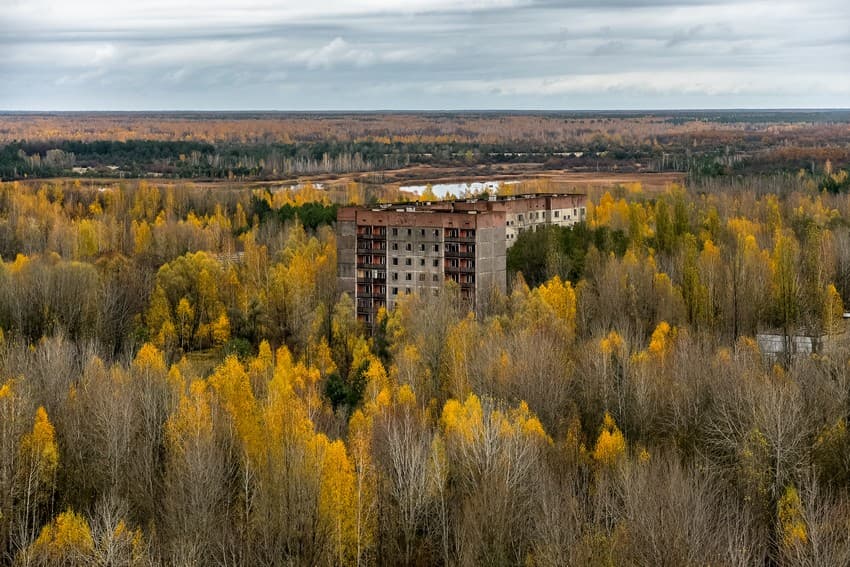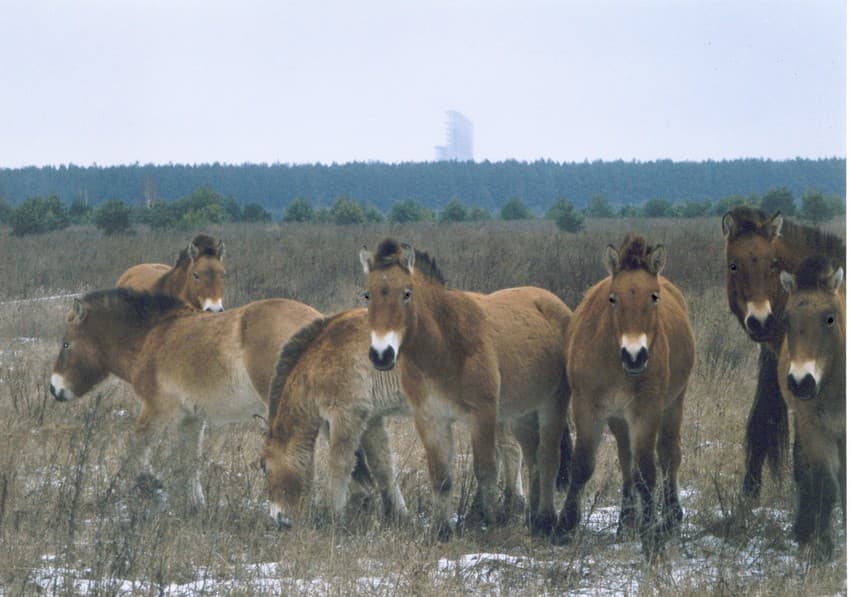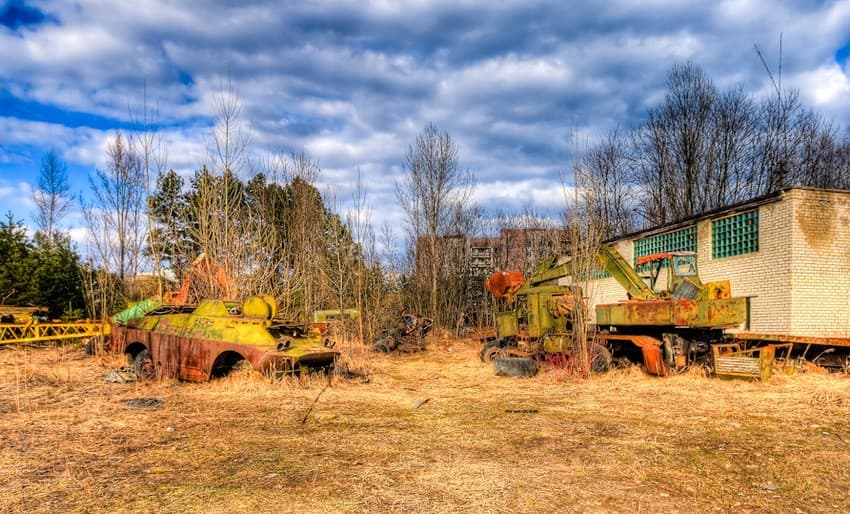On the fateful night of April 26, 1986, as the world slept, a nuclear disaster of unimaginable scale unfolded in northern Ukraine. One of the nuclear reactors of the Chernobyl Nuclear Power Plant exploded spewing radioactive substances over the next few days which spread far and wide across Ukraine, Belarus and parts of Russia. It is said that the immediate effects of the radiation were felt all the way up to Norway. In March of 2011, Japan suffered a massive earthquake and a 15 m. powerful tsunami, a combination of which disrupted the power supply and cooling of three Fukushima Daiichi reactors and triggered the deadly nuclear power plant accident. In each case, more than 100,000-200,000 people living within 30 km. radius of the nuclear disaster sites had to be evacuated.

Chernobyl Exclusion Zone, Ukraine. Photo credit – Jorge Franganillo _Public Domain
Though the radiation levels have eased in these parts over the years, the exclusion zones are far from being completely cured of radiological contamination, despite all the containment measures and cleaning up. The city of Pripyat and some other areas in the Chernobyl exclusion zone, it is estimated, will remain uninhabitable for humans for the next 1,000 to 3,000 years (some experts claim tens of thousands of years), due to the incredibly high quantities of long-lived radioisotopes released ( e.g. cesium-137) and the resulting high contamination levels. The intensity of the Chernobyl incident is often compared to the radioactivity triggered by the atomic bomb dropped on Hiroshima. Radiation that was released into the atmosphere in the case of Chernobyl, it is believed, was 400 times higher.
A WORLD WITHOUT HUMANS
Today, the Chernobyl and Fukushima exclusion zones remain more or less free of human inhabitants. This factor, and this factor alone, despite very high levels of radiation in some areas within these zones, has seen a burst of nature revival and takeover. Wolves, bisons, Prezalwski’s horses (the only remaining true wild horse subspecies which went extinct in the wild and were revived in captivity. Some were released in Chernobyl as an experiment), wild boars and beavers abound in the parts of the exclusion zone in Ukraine and Belarus which together span nearly 4,000 sq. km. Several other rare and endangered species are seen here, a place that has come to be dubbed as one of the truly wild animal sanctuaries on the planet. Vegetation has engulfed the debris left behind by humans and more. Nature is showing us how rewilding is done right. And it is only done right when left alone.

Przewalski’s horses in the radioactive Chernobyl Exlcusion Zone, Ukraine. These critically endangered horses are the only surviving subspecies of the wild horse in the world. Thirty-six individuals were introduced into the Chernobyl Exclusion Zone about 16 years ago. Photo credit – Xopc/Public Domain
There has also been overwhelming evidence of burgeoning wildlife in the evacuation zone in Fukushima despite the radiological contamination. Wild boars, raccoon dogs, Japanese macaques among other species have exploded in numbers. After the evacuation of nearly 164,000 people from around the the destroyed nuclear plant, wildlife populations spiked in abundance. As if on cue.
So, why does wildlife seem unaffected by radiation? Are the wild animals immune to it? The answer is, no. The immediate aftermath of the nuclear disasters left plants and animals in the most affected areas very sick or dead. But, very soon, the wildlife revived. Though extensive studies are yet to be performed to determine how and how much the animals are truly affected. But, the truth of the matter is that the animals in the exclusion zones are in fact radioactive, some highly so. After all, they are feeding on vegetation that is growing in radiation-filled ground. The point to note is that these effects impact the animals at individual and molecular levels. Populations, however, haven’t seemingly been impacted and do not show signs of long-term negative effects, except in areas that are most radioactive. If anything, populations of several wildlife species have only grown after humans left, as revealed by tourists and scientists who have visited, and from the thousands of images procured from camera traps laid out in hundreds of locations within the exclusion zones. Signs of uninterrupted wildlife are everywhere in this microcosm of a world without man.
HUMANS TRUMP RADIATION
What does this tell us? Are humans even deadlier than nuclear radiation? So deadly, in fact, that nature’s legendary regenerative powers fall short in their presence?
Human activities the world over have inflicted terminal habitat and biodiversity loss triggering mass extinction, a term not used lightly at all. We are in the midst of a mass extinction event, only the sixth of its kind and scale to occur in the last 500 million years. And never has one single species been central to the cause of triggering of one.
Wildlife crime has reached abysmal proportions the world over. Illegal wildlife trade is billions of dollars worth of organised crime, after only drugs, arms and human trafficking. And worse, the wildlife trade helps fund all kinds of notorious and dangerous activities, including terrorism.
The era of industrialisation has seen us overexploit and abuse natural resources to their very brink of existence. All for short-term gains, mostly money. We have broken ecosystems beyond repair, spewed vile toxic concoctions into the air, water, soil, and even into animals. There is virtually no marine organism you can find without plastic already inside it.
Look at what climate change caused by emission of billions of tonnes of carbon dioxide and other greenhouse gases into the atmosphere has unleashed. A fury of extreme weather catastrophes such as floods, sea storms, droughts, sea level rise, and raging forest fires, all of which have become the new normal, occurring at higher frequency and severity.
We are only beginning to realise the true, deadly potential of our ways. We have managed to invoke newer, dangerous viruses from wild hosts, and awaken the frozen viruses and bacteria from the ‘dead’. Case in point, the new novel coronavirus which has left the world as we know it crippled. This virus is zoonotic, which means the virus was transmitted from animal species to humans. The messy and brutal wildlife trade, destruction of natural habitats, loss of wildlife, and upending of fine balances within ecosystems are all rightfully being blamed for creating a viable world for many more such viruses to find their way from the confines of their hosts and habitats to us. Experts warn about viral pandemics like this becoming the new norm.

Militia/police station in Pripyat near Chernobyl. Photo credit Timm Seuss_Public domain
“We invade tropical forests and other wild landscapes, which harbor so many species of animals and plants—and within those creatures, so many unknown viruses. We cut the trees; we kill the animals or cage them and send them to markets. We disrupt ecosystems, and we shake viruses loose from their natural hosts. When that happens, they need a new host. Often, we are it,” wrote David Quammen, author of ‘Spillover: Animal Infections and the Next Pandemic’, in the New York Times, recently.
The idea of drawing a parallel between something as deadly as nuclear radiation and humans intrigued me. The fact that wildlife could survive, nay, thrive in areas high in radiation is baffling. Simple removal of man from a region sends nature into rewilding and regenerating frenzy. It is as if the planet is waiting to be cured of the pandemic caused by us humans. In this case, the only cure in sight seems to be the disappearance (read extinction) of man.
——————————————————————————————————————————————————————
About the Author: Purva Variyar is a conservation and science writer at the Wildlife Conservation Trust, India.
——————————————————————————————————————————————————————
Disclaimer: The author is associated with Wildlife Conservation Trust. The views and opinions expressed in the article are her own and do not necessarily reflect the views and opinions of Wildlife Conservation Trust.
Related Links
- Protecting Our Protectors – Health Challenges Faced By India’s Frontline Forest Staff
- Tightening The Noose On Wildlife Crime
- Illegal Wildlife Trade: The Need to Look Within
- Averting Extinction – One Blood Sample at a Time
- Spotlight On The Royal Bengal Tiger: An Ageless Chronicle Of The Soul Of India
